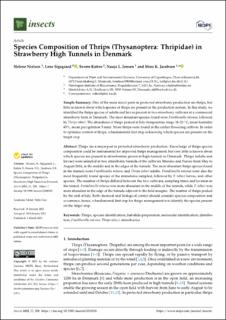| dc.description.abstract | Simple Summary: One of the main insect pests in protected strawberry production are thrips, but little is known about which species of thrips are present in the production system. In this study, we identified the thrips species of adults and larvae present in two strawberry cultivars at a commercial strawberry farm in Denmark. The most abundant species found were Frankliniella intonsa, followed by Thrips tabaci. The abundance of thrips peaked in July (temperature range 18–23 ◦C, mean humidity 65%, mean precipitation 5 mm). More thrips were found in the earlier flowering cultivar. In order to optimize control of thrips, a fundamental first step is knowing which species are present on the target crop. Abstract: Thrips are a major pest in protected strawberry production. Knowledge of thrips species composition could be instrumental for improved thrips management, but very little is known about which species are present in strawberries grown in high-tunnels in Denmark. Thrips (adults and larvae) were sampled in two strawberry tunnels of the cultivars Murano and Furore from May to August 2018, in the middle and in the edges of the tunnels. The most abundant thrips species found in the tunnels were Frankliniella intonsa and Thrips tabaci adults. Frankliniella intonsa were also the most frequently found species of the immatures sampled, followed by T. tabaci larvae, and other species. The number of thrips differed between the two cultivars, sampling times and location in the tunnel. Frankliniella intonsa was more abundant in the middle of the tunnels, while T. tabaci was more abundant in the edge of the tunnels adjacent to the field margins. The number of thrips peaked by the end of July. Both chemical and biological control should consider species composition and occurrence; hence, a fundamental first step for thrips management is to identify the species present on the target crop. | en_US |

